Oh dear.
I promise this isn’t shameless self-promotion here. There’s nothing about this book that has to do with me, except for the fact that I love the book…and the fact that my name is on the cover.
There’s a new edition to Beginner’s Guide to Goldwork by Ruth Chamberlin out. I wrote the foreward. Why? Because I love the book!
I reviewed Beginner’s Guide to Goldwork a long time ago, way back in 2007. It became hard to find for a while, and now it’s been re-issued – a great boon to embroiderers everywhere, because now the book is widely available again, and affordably so!
There are many reasons why this book nestles deep within the cockles of my heart, but there’s one reason in particular. I’ll share that with you today, because if you’re anything like me when it comes to your embroidery journey, you’ll understand!
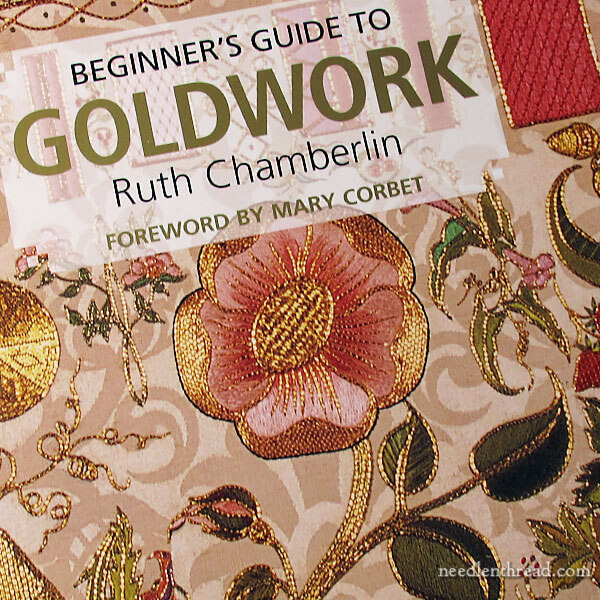
Besides the book being a practical instructional guide, and besides the book housing some really stunning goldwork embroidery, and besides the book featuring a drop-dead-gorgeous silk and gold embroidery sampler to work – all of these being good reasons for loving the book and wanting it on your shelf – there’s a much Bigger Reason that I love it.
To understand the reason, you have to come back with me to the very beginning of my interest in the art of embroidery.
Rewind to the first half of the 1990’s. I was in college. I saw stuff at museums. Goldwork. Silk. Magnificent embroideries. And I saw stuff in books, too. Mostly in old books. Sometimes, old stuff in new books.
I wanted to know about that stuff. I wanted to know how it was made. I wanted to know who made it. I wanted to know where all the people are who make the same stuff today! I wanted to know where to find the threads. I wanted to know … ! Well, I wanted to know everything I could wrap my brain around about this gold embroidery that I saw in these old books, in these history of art books, in these museum exhibits.
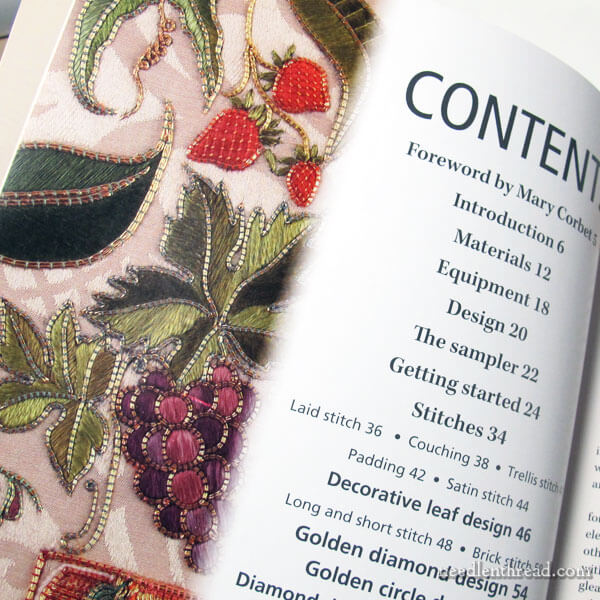
But you know, back in the 1990’s – sooooo verrrrry loooooong ago – we didn’t have easy access to the internet as we know it today. Instead, we had these buildings called libraries, that you actually walk into with your legs, and these buildings had these things in them called books.
And the research you could do in those libraries was limited in many ways. The most obvious limitation was that the library that you had easy access to was usually limited in their collections to topics that were pertinent to the patrons of the libraries. To actually find one particular book on goldwork in the 1990’s in a college library in Kansas – or even in a public library – was nigh on impossible.
Enter: the interlibrary loan. I was able to get my hands on some books, but nothing that told me about the art of goldwork embroidery today.
And heck, I was in Kansas. No offense, Kansas. But cross stitch and quilting just didn’t do it for me, and that’s all you offered!
But I did what I could, collecting books, visiting used bookstores (we have some good ones out here), putting my name on search lists and want lists through those bookstores. And eventually, I amassed my own little collection of old books.
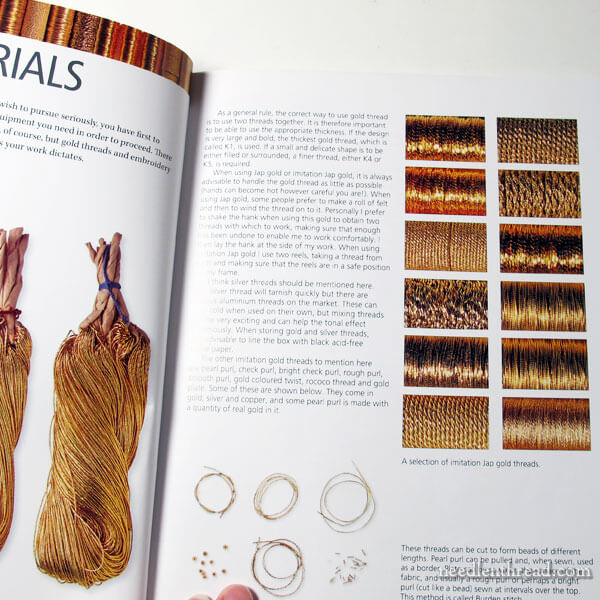
I began dabbling with needle and thread, using supplies that I could get ahold of locally, because I really didn’t know anything about how or where to find fine embroidery supplies.
The results of my first trials at “goldwork,” with cotton floss and metallic threads, were a bit underwhelming, to say the least!
In any case, during that same time, my sister subscribed to a new Australian needlework publication (called Inspirations Magazine!), and it was actually through Inspirations that I started to learn something about fine embroidery, about what I would call the art of embroidery. I also discovered that there were places you could get ahold of something other than cotton floss and metallic thread.
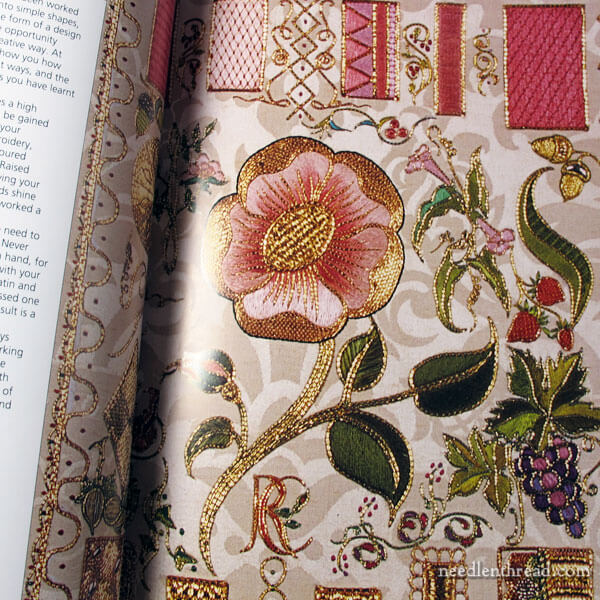
The years went by, and I learned stuff. And I collected more books. And I played around with my needle and thread.
But I was forever intimidated by goldwork embroidery. No matter the publication, no matter the book, it always seemed to me that goldwork (and the often-connected silk embroidery that comes along with it) was placed on a pedestal.
In practically every publication that I had access to, goldwork came across as the Inaccessible Height of the Art of Embroidery, only for Those Who Scale the Mountain and are Endowed by the Gods with The Gift.
And deep pockets.
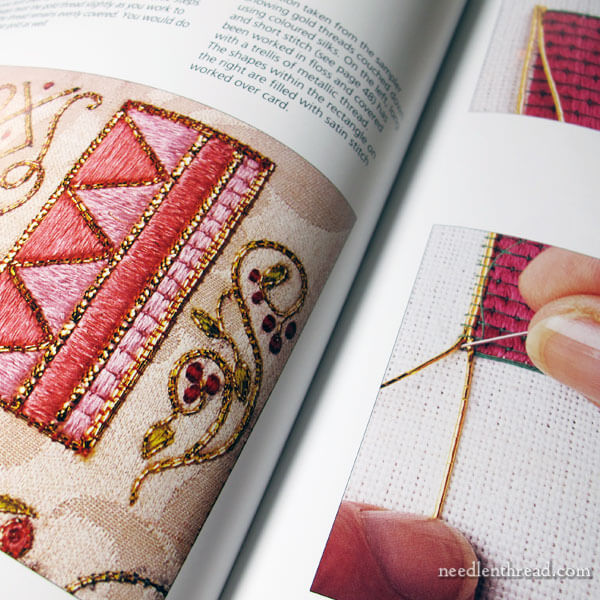
And it wasn’t until I had Ruth Chamberlin’s book in my hands one day – in 2007! – that I realized that my impression of goldwork – and the “intimidation factor” that hovered around goldwork – was all just bunkum.
See, goldwork is just a matter of stitching. And if you can take your needle and thread up into fabric and put it down into fabric, you can do goldwork!
Beautiful, real goldwork.
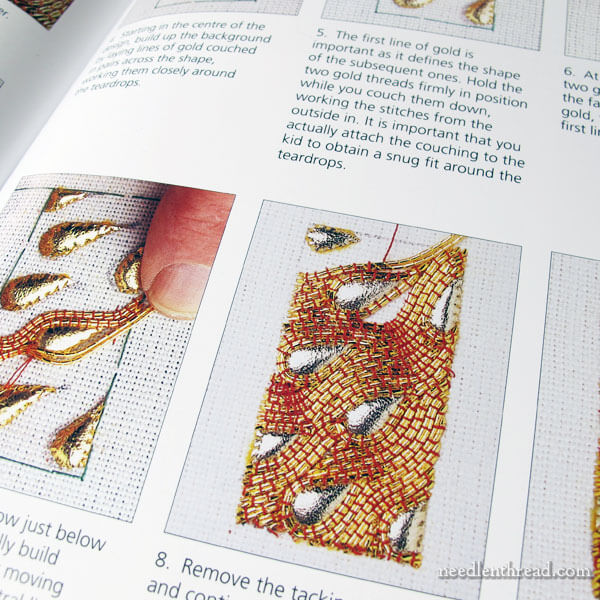
And that’s what this book taught me. Not to be intimidated by goldwork. It isn’t just for the Specially Endowed, the Ones who Climb the Mountain. It’s accessible to anyone who has an interest in pursuing it.
And this is why Ruth Chamberlin’s Beginner’s Guide to Goldwork nestles deep in the cockles of my heart! And this is why I was happy and honored to write the forward for the new edition.
Where to Find It
If you’d like to add Beginner’s Guide to Goldwork to your needlework library – and I think you should, if you have the slightest interest in goldwork embroidery – you can find the new edition through the following book affiliates:
In the US, you can find Beginner’s Guide to Goldwork here for pre-order, through Amazon.
Worldwide with free shipping, it’s available here now, through Book Depository.
It’s a beautiful book. It’s full of instruction. It will show you the wonders of goldwork and it will teach you – like it did me – that goldwork is accessible to anyone who has an interest in it!







Dear Mary,
I absolutely love this book too! I have one question regarding the new edition. Apart from the the foreword you’ve written is there anything different from the first edition in terms of content?
Thank you.
Hi, Catalina – no, it’s the same content over all. If you already have the book, you’re good!
Thank you!
Oh joy! At last a new edition. Thanks for posting this. Ever since I read your first review of this book a few years ago I have been searching for it but I couldn’t find it anywhere. Well I just snapped up a copy for myself and can’t wait to read it. As well, I want to thank you for your contribution to the needle craft word and to my love of the craft as well. You’ve had a big influence on me. 🙂
So exciting, Mary! Thank you for playing such an important role in helping to make such an exquisite art more “possible” for the rest of us! 🙂
Oh I enjoyed reading this article Mary, and especially your embroidery back story. I was at college in the mid ’90’s and that was about the time when needlework started to make an impression on me. It’s true though, the explosion of interest and information available then was mainly about cross stitch (and needlepoint here in the UK). I started with cross stitch, and then came across a delightful magazine ‘Mary Hickmotts New Stitches’ … now no longer published unfortunately. What was unique about that magazine was the variety of techniques it introduced. When most other magazines were pure cross stitch with maybe a little very simple Hardanger embroidery, New Stitches was also featuring drawn thread, pulled thread, silk shading, blackwork and goldwork embroidery. There was a sense of progression with each issue and there were sometimes three-part RSN feature projects … which was how I first came across goldwork and saw how achievable it actually was. That magazine, and Inspirations which I subsequently discovered have been hugely enabling in terms of learning new techniques and sourcing the supplies. I feel like they have provided an informal kind of needlework apprenticeship for the hobby embroiderer and promoted a high level of skill whilst making it accessible. I think we’ve been very fortunate to have been surrounded by so much information and inspiration. Thanks for the trip down memory lane this morning Mary, and all that you have done to make embroidery accessible as well! 🙂
That looks a most enticing book, Mary! Sumptuous stuff. So many people never have the confidence to get through the ‘I couldn’t do that!’ barrier, which is a great shame. Attention to detail, willingness to learn, enough practice to get to know tools, fabrics, threads and techniques, and the cheerful acceptance that fine work will take a very long time, especially at first. That’s about it, really. Apart from confidence, it’s lack of patience that usually stops folk progressing, I find. I guess you developed that while waiting for inter-library loans and digging for gold in old books with confusing instructions and cloudy photographs!
Thank you for your newsletters. I ordered the goldwork book, from Book Depository. Looking forward to using gold threads I have collected. Thank you again
I do love the way you write: Inaccessible Height, Those Who Scale the Mountain, Endowed with the Gift. 🙂 That is exactly how I feel about embroidery overall. My chain stitch has uneven links, my lazy daisies have been beaten by a hurricane and my satin stitch looks very much like rumpled bed covers in the morning. LOL
I’m not sure I’ll ever try gold work but I do love to see you create with it all. Just want to say thanks for all you do and share with us.
I have the first edition and am about to start a gold work project as my “spring stitching”. Are there significant changes in the new edition (other than your wonderful forward)? Would it benefit me to buy the new one, or is basically a reprint of the first edition? Thank you!
Oh, sorry – should have read the previous posts; just saw your answer that the content is the same.
It’s finally happened-my interest in goldwork has skyrocketed when I saw this book! Haven’t heard of this particular book before. Thank you for introducing it to us!
Does the book contain project?
Hi, Beth – yes, it does! The whole book revolves around one large goldwork and silk sampler, but each element in the sampler – like the individual rose, the grapes, etc., can be worked separately.
Me again-just purchased the book from Book Depository for $9.72, half the price from Amazon.
Is there a good source in the US for goldwork threads besides the one in GA?
Hi, Beth – Hedgehog Handworks (which is going out of business – the owner is retiring) has the most thorough selection of goldwork threads in the US. She may still have some listed on her site (everything site-wide is 20% off right now). You could check there. Otherwise, for an extensive selection, you can try Tanja Berlin in Canada (berlinembroidery.com) – she has an excellent selection and a lot of explanatory notes on the different threads.
Thank you, Mary.
I have this book as well as a few others. This one is pure eye candy!!! Enjoy!! Well worth the $$! Linda in NC
Dear Mary
I hope you are well? long time no write, I been in Norwary attending my Niece’s wedding so just back, had a great time celebrating. I loved the post and your memories of goldwork embroidery. It looks a really good book and very useful for getting to know goldowrk. I’ve learnt all my embroidery techniques from you and they have been an inspiration to me, it must have been all that research and collecting you have done over the years that has made you such an inspiration to us all. Thanks for sharing your embroidery goldwork memories with us and for reviewing the book.
Regards Anita Simmance
“But cross stitching and quilting just didn’t do it for me…” Why is cross stitch so disrespected by “real” embroiderers? I am honestly asking that question, Mary and others. I think the different visual effect of both forms are equally beautiful (and in my own stitching life have devoted nearly equal time to each). But this snobbery does exist. I’ve been reading your blog for years, and I’m sorry to see it here, too. Please help me understand.
Hi, Linda – it’s not really snobbery. I do counted work, and I like it when I do it. But at that point in my life, when I was looking for information on surface embroidery and goldwork, here in the US there was very little other than cross stitch and needlepoint readily available, and here in Kansas, the big things were quilting and cross stitch. I could find quilting and cross stitch stores, but I couldn’t find anything at all on surface embroidery in my area. And in fact, it is still pretty much the case in my part of Kansas. So it’s not really a snob thing – just the facts.
Thanks for your response, Mary.
Speaking for myself, something about making the same stitch over and over, counting (or miscounting!), matching thread color to symbols, just doesn’t appeal to me. Maybe because I learned free-style surface embroidery first?
I don’t disrespect the cross stitchers or the technique. But the simple blocky patterns with no shading and cute sayings that were so common in the 80s are what comes to my mind first when I hear “cross stitch”. Don’t feel too bad, when I think of crewel, the first thing that comes to mind is the kits with smiling turtles, frogs and mushrooms from the 70s. In both cases, those were my first exposure to the techniques. I’d say it’s more my taste in the results have changed over the (gulp!) decades, than my opinion of the technique.
JustGail, thanks for your honest–and funny!–reply, which I think astutely reflects the reasons why a lot of people dismiss counted work. I would like to point out that cross stitch designs have evolved a whole heck of a lot(!) since the ’80s (I too remember those blocky, cutesy designs), as have the fibers, beads, and fabrics used. I really do love the differences between the two forms: the raised, varied textures of free-style surface embroidery stitches contrasted with the flatness and uniformity of counted work stitches, which almost become part of the fabric. I enjoy doing both, and I think the end result of each is wonderful.
Mary, I just came across this project which I thought you and your readers might be interested in: http://www.amymeissner.com/inheritance-project.html A textile artist invited people to send her their inherited textiles to form an amazing display. There are examples of all kinds of needlework, some very skilled and some less so, from well over a hundred years. Some is the work of much beloved parents, grandparents and other ancestors; some has unknown origins. All together they are moving and joyful and fascinating.
How do i order this books.
Hi, Ranjana – There are links at the end of the article.
Ohhh Mary,
Your link to the Book Depository has opened me up to almost unbearable temptation. All those embroidery books just a mouse click away. Even showing in local currency (no unpleasant surprises with exchange rates hopefully) and free shipping. I shall have to be very strong. It would be soooo easy to seriously damage my credit card!!!
Only just over CAN$13 so affordable.
As it happens I am thinking of trying my hand at goldwork, I think I will have to put this book on my list!
Hi Mary. I ordered it even though I am seriously daunted by the idea of goldwork at this level. It’s a good thing to have in my slowly, slowly growing library, and maybe some day I will gird my loins and give it a go.
Your enthusiasm and eloquence are just amazing. I must have this book. thank you.
Thanks for the heads up Mary. I ordered it from Amazon (for $13.36) but checked Book Depository just for heck of it – it was $9.70. So, if you want to order, Book Depository is cheaper.
I was fortunate to buy a copy, second hand, a few years ago. Absolutely beautiful and a wonderful book to use when working up your own designs.
Gold work looks so elegant. And yes, intimidating. But it is so very beautiful. From the pictures you showed, I need this book in my library!
Fabulous looking book seems crammed full of information that I need for my enjoyment of my most favourite past time in life.
I recently purchased this book as a newby to goldwork and I was excited when I received my copy. I. Wanted. To use this book as a learning guide However, the directions for the sampler are very vague and it doesn’t even specify a supply list. I am very disappointed. With your recommendation, I thought this book would be a better guide.
Hi, Karen – the book is a guide through the techniques used in the sampler. I don’t have a copy out with me right now, but I think she does indicate the types of threads – I think there’s an index of threads in it? The book isn’t presented, though, as a step-by-step single project book, but if you follow it cover to cover, it does take the reader through all the techniques used in the elements in her sampler. The goldwork techniques she covers are all laid (couched) threads, though. Chip work doesn’t really figure into it, so it’s not a thorough covering of all kinds of goldwork, but just couched goldwork. Are you looking for something that teaches the different aspects of goldwork through specific projects? In that case, Hazel Everett’s book is the way to go: https://needlenthread.wpengine.com/2011/09/goldwork-techniques-projects-and-pure-inspiration-book-review.html The projects are listed as you’d expect in a project book rather than simply a technique book. Another book that would work well as a learning guide – but isn’t project heavy – is the A-Z of Goldwork: https://needlenthread.wpengine.com/2008/09/it-came-it-came-and-wow-what-book-z-of.html But yes, if you’re after specific projects that will take you through a thorough learning process for goldwork, I’d go with Hazel’s.
Thanks Mary. I have never done goldwork before so this is no the book for me, though I love the sampler and would dive right in if there were directions.
I will check out Hazel’s book. I have several others of hers and she does do a good job. Thanks again for responding so quickly.